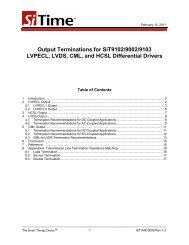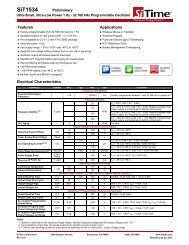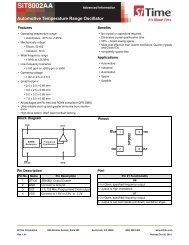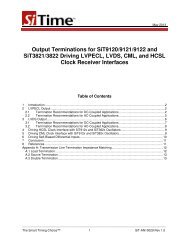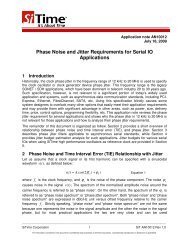pdf datasheet - SiTime
pdf datasheet - SiTime
pdf datasheet - SiTime
You also want an ePaper? Increase the reach of your titles
YUMPU automatically turns print PDFs into web optimized ePapers that Google loves.
Silicon MEMS Outperforms Quartz<br />
The Smart Timing Choice<br />
The Smart Timing Choice<br />
Best Vibration Robustness<br />
High-vibration environments are all around us. All electronics,<br />
from handheld devices to enterprise servers and storage<br />
systems are subject to vibration. Figure 5 shows a comparison<br />
of vibration robustness.<br />
Why is <strong>SiTime</strong> Best in Class:<br />
• The moving mass of <strong>SiTime</strong>’s MEMS resonators is up to<br />
3000 times smaller than quartz<br />
• Center-anchored MEMS resonator is the most robust<br />
design<br />
Best Shock Robustness<br />
<strong>SiTime</strong>’s oscillators can withstand at least 50,000 g shock.<br />
They all maintain their electrical performance in operation<br />
during shock events. A comparison with quartz devices is<br />
shown in Figure 6.<br />
Why is <strong>SiTime</strong> Best in Class:<br />
• The moving mass of <strong>SiTime</strong>’s MEMS resonators is up to<br />
3000 times smaller than quartz<br />
• Center-anchored MEMS resonator is the most robust<br />
design<br />
Vibration Sensitivity (ppb/g)<br />
100.00<br />
10.00<br />
1.00<br />
0.10<br />
Vibration Sensitivity vs. Frequency<br />
<strong>SiTime</strong> TXC Epson Connor Winfield Kyocera SiLabs<br />
<strong>SiTime</strong><br />
Up to 30x<br />
Better<br />
10 100 1000<br />
Vibration Frequency (Hz)<br />
Peak Frequency Deviation (PPM)<br />
16<br />
14<br />
12<br />
10<br />
8<br />
6<br />
4<br />
2<br />
0<br />
14.3<br />
Differential XO Shock Robustness - 500 g<br />
12.6<br />
3.9<br />
2.9<br />
2.5<br />
<strong>SiTime</strong><br />
Up to 25x<br />
Better<br />
0.6<br />
Kyocera Epson TXC CW SiLabs <strong>SiTime</strong><br />
Figure 5. Vibration Robustness [5]<br />
Figure 6. Shock Robustness [6]<br />
Notes:<br />
1. Data Source: Reliability documents of named companies.<br />
2. Data source: <strong>SiTime</strong> and quartz oscillator devices <strong>datasheet</strong>s.<br />
3. Test conditions for Electro Magnetic Susceptibility (EMS):<br />
• According to IEC EN61000-4.3 (Electromagnetic compatibility standard)<br />
• Field strength: 3V/m<br />
• Radiated signal modulation: AM 1 kHz at 80% depth<br />
• Carrier frequency scan: 80 MHz – 1 GHz in 1% steps<br />
• Antenna polarization: Vertical<br />
• DUT position: Center aligned to antenna<br />
Devices used in this test:<br />
<strong>SiTime</strong>, SiT9120AC-1D2-33E156.250000 - MEMS based - 156.25 MHz<br />
Epson, EG-2102CA 156.2500M-PHPAL3 - SAW based - 156.25 MHz<br />
TXC, BB-156.250MBE-T - 3rd Overtone quartz based - 156.25 MHz<br />
Kyocera, KC7050T156.250P30E00 - SAW based - 156.25 MHz<br />
Connor Winfield (CW), P123-156.25M - 3rd overtone quartz based - 156.25 MHz<br />
SiLabs, Si590AB-BDG - 3rd overtone quartz based - 156.25 MHz<br />
4. 50 mV pk-pk Sinusoidal voltage.<br />
Devices used in this test:<br />
<strong>SiTime</strong>, SiT8208AI-33-33E-25.000000, MEMS based - 25 MHz<br />
NDK, NZ2523SB-25.6M - quartz based - 25.6 MHz<br />
Kyocera, KC2016B25M0C1GE00 - quartz based - 25 MHz<br />
Epson, SG-310SCF-25M0-MB3 - quartz based - 25 MHz<br />
5. Devices used in this test: same as EMS test stated in Note 3.<br />
6. Test conditions for shock test:<br />
• MIL-STD-883F Method 2002<br />
• Condition A: half sine wave shock pulse, 500-g, 1ms<br />
• Continuous frequency measurement in 100 μs gate time for 10 seconds<br />
Devices used in this test: same as EMS test stated in Note 3<br />
7. Additional data, including setup and detailed results, is available upon request to qualified customers. Please contact productsupport@sitime.com.<br />
Silicon MEMS Outperforms Quartz Rev. 1.0 www.sitime.com



